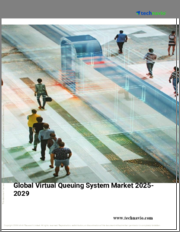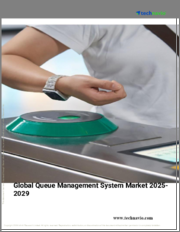
|
시장보고서
상품코드
1675287
세계의 대기열 관리 시스템 시장 : 제공별, 전개 모델별, 모드별, 용도별, 업종별, 지역별(2025-2033년)Queue Management System Market Report by Offering, Deployment Model, Mode, Application, Industry Vertical, and Region 2025-2033 |
||||||
대기열 관리 시스템 시장 세계 시장 규모는 2024년에 5억 9,840만 달러에 달했습니다. 향후 IMARC Group은 2033년까지 8억 6,130만 달러에 달하고, 2025년부터 2033년까지 3.92%의 연평균 성장률(CAGR)을 나타낼 것으로 예측했습니다. 헬스케어 산업에서 환자 문의를 쉽게 처리하고 질병 확산을 방지하기 위해 도입이 증가하고 있으며, 고객 참여도를 높이기 위한 사용 증가, 고객 트래픽 관리에 대한 수요 증가가 시장을 이끄는 주요 요인 중 하나입니다.
대기열 관리 시스템 시스템은 대기열 관리 및 정리 프로세스를 간소화하기 위해 설계된 소프트웨어 기반 솔루션입니다. 대기열의 성능 및 패턴, 고객 흐름과 행동, 서비스 지표에 대한 데이터와 분석을 생성합니다. 대기열 대기 시간을 실시간으로 업데이트하고 고객과의 상호 작용을 관리합니다. 또한, 서비스 투명성을 높이고 대기 시간 동안 개인의 불안과 좌절감을 줄여줍니다. 고객 충성도와 유지율을 높이고 서비스 제공의 개인화를 개선합니다. 대기열 관리 시스템 시스템은 고객 경험 향상, 서비스 효율성 최적화, 대기 시간 단축을 지원합니다. 직원의 생산성을 향상시킴으로써 직원들은 고객 안내에 더 집중할 수 있습니다. 이 외에도 비즈니스 수익성을 높이고 커뮤니케이션을 간소화하는 데에도 도움이 됩니다. 그 결과, 대기열 관리 시스템 시스템은 헬스케어, IT 및 통신, 여행 및 숙박, 에너지 및 유틸리티 등 전 세계 다양한 산업에서 널리 사용되고 있습니다.
대기열 관리 시스템 시장 동향 :
현재 헬스케어 산업에서는 환자의 문의를 쉽게 처리하고 개인 간 질병 확산을 방지하기 위해 대기열 관리 시스템의 채택이 증가하고 있으며, 이는 시장 성장을 뒷받침하는 중요한 요인 중 하나입니다. 이와 더불어, 매장의 생산성을 높이기 위해 고객의 출입과 이동을 관리하는 대기열 관리 시스템에 대한 수요가 증가하고 있는 것도 시장에 긍정적인 영향을 미치고 있습니다. 또한, 고객 참여를 강화하기 위한 대기열 관리 시스템 시스템의 사용 증가는 업계 투자자들에게 유리한 성장 기회를 제공합니다. 이와는 별도로, 개인의 시간을 절약할 수 있는 비용 효율적이고 효율적인 대기열 솔루션에 대한 수요가 전 세계적으로 증가하고 있습니다. 이는 매장의 과밀을 피하기 위한 대기열 관리 시스템 시스템의 채택 증가와 함께 시장 성장을 가속하고 있습니다. 또한, 실시간 경고 및 알림을 제공하는 인공지능(AI) 및 분석과 같은 첨단 기술이 부상하고 있는 것도 시장 성장에 기여하고 있습니다. 또한, 의사 결정 개선에 도움이 되는 고객 흐름을 파악하기 위한 대기열 관리 시스템 시스템에 대한 수요 증가는 좋은 시장 전망을 제공합니다. 또한, 고객에게 다음 이용 가능한 카운터로 자동 이동을 요청하는 자동 대기열 관리 시스템 시스템의 채택이 증가함에 따라 시장 성장을 가속하고 있습니다.
본 보고서에서 다룬 주요 질문
- 세계 대기열 관리 시스템 시장은 지금까지 어떻게 성장해 왔는가?
- 대기열 관리 시스템 시장 세계 시장에서 촉진요인, 억제요인, 기회는?
- 각 촉진요인, 억제요인 및 기회가 세계 대기열 관리 시스템 시장에 미치는 영향은?
- 주요 지역 시장은?
- 가장 매력적인 대기열 관리 시스템 시장은 어느 국가인가?
- 제공에 따른 시장 내역은?
- 대기열 관리 시스템 시장에서 가장 매력적인 제품은?
- 전개모델에 따른 시장 분석은?
- 대기열 관리 시스템 시장에서 가장 매력적인 전개 모델은 무엇인가?
- 모드별 시장 분석은?
- 대기열 관리 시스템 시장에서 가장 매력적인 모드는 무엇인가?
- 용도별 시장 분석은?
- 대기열 관리 시스템 시장에서 가장 매력적인 용도는 무엇인가?
- 업종별 시장 현황은?
- 대기열 관리 시스템 시장에서 가장 매력적인 업종은?
- 세계 대기열 관리 시스템 시장 경쟁 구도는?
- 세계 대기열 관리 시스템 시장의 주요 기업은?
목차
제1장 서문
제2장 조사 범위와 조사 방법
- 조사 목적
- 이해관계자
- 데이터 소스
- 1차 정보
- 2차 정보
- 시장 추정
- 보텀업 접근
- 톱다운 접근
- 조사 방법
제3장 주요 요약
제4장 서론
- 개요
- 주요 업계 동향
제5장 세계의 대기열 관리 시스템 시장
- 시장 개요
- 시장 실적
- COVID-19의 영향
- 시장 예측
제6장 시장 분석 : 제공별
- 솔루션
- 주요 부문
- 하드웨어
- 소프트웨어
- 주요 부문
- 서비스
- 주요 부문
- 전문 서비스
- 매니지드 서비스
- 주요 부문
제7장 시장 분석 : 전개 모델별
- 온프레미스
- 클라우드 기반
제8장 시장 분석 : 모드별
- Virtual Queuing
- Linear Queuing
제9장 시장 분석 : 용도별
- 보고서 및 분석
- 실시간 모니터링
- 예약 관리
- 고객 서비스
- 쿼리 처리
- 점포 관리
- 기타
제10장 시장 분석 : 업종별
- 은행, 금융서비스 및 보험(BFSI)
- 소매 및 소비재
- 헬스케어 및 생명과학
- 정부 및 공공 부문
- IT 및 통신
- 여행 및 호스피탈리티
- 에너지 및 유틸리티
- 기타
제11장 시장 분석 : 지역별
- 북미
- 미국
- 캐나다
- 아시아태평양
- 중국
- 일본
- 인도
- 한국
- 호주
- 인도네시아
- 기타
- 유럽
- 독일
- 프랑스
- 영국
- 이탈리아
- 스페인
- 러시아
- 기타
- 라틴아메리카
- 브라질
- 멕시코
- 기타
- 중동 및 아프리카
- 시장 분석 : 국가별
제12장 성장 촉진요인 및 억제요인, 기회
- 개요
- 성장 촉진요인
- 성장 억제요인
- 기회
제13장 밸류체인 분석
제14장 Porter의 Five Forces 분석
- 개요
- 바이어의 교섭력
- 공급 기업의 교섭력
- 경쟁 정도
- 신규 진출업체의 위협
- 대체품의 위협
제15장 가격 분석
제16장 경쟁 구도
- 시장 구조
- 주요 기업
- 주요 기업 개요
- Advantech Co. Ltd.
- AKIS Technologies UAB
- ATT Systems Group
- Aurionpro Solutions Limited
- Awebstar Technologies Pte Ltd.
- MaliaTec(Malia Group)
- QLess Inc.
- Q-Matic AB
- Q-nomy Inc.
- Qudini Limited(Verint Systems Inc.)
- Skiplino
- XIPHIAS Software Technologies Pvt. Ltd.
- Xtreme Media Pvt. Ltd
The global queue management system market size reached USD 598.4 Million in 2024. Looking forward, IMARC Group expects the market to reach USD 861.3 Million by 2033, exhibiting a growth rate (CAGR) of 3.92% during 2025-2033. The growing adoption in the healthcare industry for handling patient queries easily and avoiding the spread of diseases, increasing utilization to enhance customer engagement, and rising demand to manage customer traffic represent some of the key factors driving the market.
Queue management system is a software-based solution that is designed to streamline the process of managing and organizing queues. It generates data and analytics on queue performance and patterns, customer flow and behavior, and service metrics. It provides real-time updates on queue wait times and manages customer interactions. It also offers increased service transparency and reduces uncertainty or frustration among individuals during the waiting period. It increases customer loyalty and retention rates and improves personalization of service delivery. Queue management system assists in improving customer experience, optimizing service efficiency, and decreasing waiting time. It aids in enhancing staff productivity by allowing staff members to focus more on guiding customers. Besides this, it is beneficial in increasing profitability of a business and streamlining communications. As a result, queue management system is widely employed in the healthcare, IT and telecom, travel and hospitality, and energy and utilities industries across the globe.
Queue Management System Market Trends:
At present, the rising adoption of queue management systems in the healthcare industry for handling patient queries easily and avoiding spread of diseases among individuals represents one of the key factors supporting the growth of the market. Besides this, the growing demand for queue management systems to manage customer traffic and movement to boost productivity in a store is positively influencing the market. Additionally, the increasing utilization of queue management systems to enhance customer engagement is offering lucrative growth opportunities to industry investors. Apart from this, there is a rise in the demand for cost-effective and efficient queue solutions that save time for individuals across the globe. This, coupled with the increasing adoption of queue management systems to avoid store overcrowding, is impelling the growth of the market. In addition, the rising emergence of advanced technologies, such as artificial intelligence (AI) and analytics, that provide real-time alerts and notifications is contributing to the growth of the market. Moreover, the growing demand for queue management systems to identify customer flow that helps in improving decision-making is offering a favorable market outlook. Furthermore, the rising adoption of automated queue management systems that automatically request customers to move forward to the next accessible counter is propelling the growth of the market.
Key Market Segmentation:
Offering Insights:
- Solution
- Hardware
- Software
- Service
- Professional Service
- Managed Service
Deployment Model Insights:
- On-premises
- Cloud-based
Mode Insights:
- Virtual Queuing
- Linear Queuing
Application Insights:
- Reporting and Analytics
- Real-Time Monitoring
- Appointment Management
- Customer Service
- Query Handling
- In-Store Management
- Others
Industry Vertical Insights:
- BFSI
- Retail and Consumer Goods
- Healthcare and Life Sciences
- Government and Public Sector
- IT and Telecom
- Travel and Hospitality
- Energy and Utilities
- Others
Regional Insights:
- North America
- United States
- Canada
- Asia Pacific
- China
- Japan
- India
- South Korea
- Australia
- Indonesia
- Others
- Europe
- Germany
- France
- United Kingdom
- Italy
- Spain
- Russia
- Others
- Latin America
- Brazil
- Mexico
- Others
- Middle East and Africa
- The report has also provided a comprehensive analysis of all the major regional markets, which include North America (the United States and Canada); Asia Pacific (China, Japan, India, South Korea, Australia, Indonesia, and others); Europe (Germany, France, the United Kingdom, Italy, Spain, Russia, and others); Latin America (Brazil, Mexico, and others); and the Middle East and Africa. According to the report, North America was the largest market for queue management system. Some of the factors driving the North America queue management system market included the growing adoption to manage large customer queues, presence of various market players, increasing introduction of advanced technologies in the region, etc.
Competitive Landscape:
- The report has also provided a comprehensive analysis of the competitive landscape in the global queue management system market. Detailed profiles of all major companies have been provided. Some of the companies covered include Advantech Co. Ltd., AKIS Technologies UAB, ATT Systems Group, Aurionpro Solutions Limited, Awebstar Technologies Pte Ltd., MaliaTec (Malia Group), QLess Inc., Q-Matic AB, Q-nomy Inc., Qudini Limited (Verint Systems Inc.), Skiplino, XIPHIAS Software Technologies Pvt. Ltd., Xtreme Media Pvt. Ltd, etc. Kindly note that this only represents a partial list of companies, and the complete list has been provided in the report.
Key Questions Answered in This Report:
- How has the global queue management system market performed so far, and how will it perform in the coming years?
- What are the drivers, restraints, and opportunities in the global queue management system market?
- What is the impact of each driver, restraint, and opportunity on the global queue management system market?
- What are the key regional markets?
- Which countries represent the most attractive queue management system market?
- What is the breakup of the market based on the offering?
- Which is the most attractive offering in the queue management system market?
- What is the breakup of the market based on the deployment model?
- Which is the most attractive deployment model in the queue management system market?
- What is the breakup of the market based on the mode?
- Which is the most attractive mode in the queue management system market?
- What is the breakup of the market based on the application?
- Which is the most attractive application in the queue management system market?
- What is the breakup of the market based on the industry vertical?
- Which is the most attractive industry vertical in the queue management system market?
- What is the competitive structure of the global queue management system market?
- Who are the key players/companies in the global queue management system market?
Table of Contents
1 Preface
2 Scope and Methodology
- 2.1 Objectives of the Study
- 2.2 Stakeholders
- 2.3 Data Sources
- 2.3.1 Primary Sources
- 2.3.2 Secondary Sources
- 2.4 Market Estimation
- 2.4.1 Bottom-Up Approach
- 2.4.2 Top-Down Approach
- 2.5 Forecasting Methodology
3 Executive Summary
4 Introduction
- 4.1 Overview
- 4.2 Key Industry Trends
5 Global Queue Management System Market
- 5.1 Market Overview
- 5.2 Market Performance
- 5.3 Impact of COVID-19
- 5.4 Market Forecast
6 Market Breakup by Offering
- 6.1 Solution
- 6.1.1 Market Trends
- 6.1.2 Key Segments
- 6.1.2.1 Hardware
- 6.1.2.2 Software
- 6.1.3 Market Forecast
- 6.2 Service
- 6.2.1 Market Trends
- 6.2.2 Key Segments
- 6.2.2.1 Professional Service
- 6.2.2.2 Managed Service
- 6.2.3 Market Forecast
7 Market Breakup by Deployment Model
- 7.1 On-premises
- 7.1.1 Market Trends
- 7.1.2 Market Forecast
- 7.2 Cloud-based
- 7.2.1 Market Trends
- 7.2.2 Market Forecast
8 Market Breakup by Mode
- 8.1 Virtual Queuing
- 8.1.1 Market Trends
- 8.1.2 Market Forecast
- 8.2 Linear Queuing
- 8.2.1 Market Trends
- 8.2.2 Market Forecast
9 Market Breakup by Application
- 9.1 Reporting and Analytics
- 9.1.1 Market Trends
- 9.1.2 Market Forecast
- 9.2 Real-Time Monitoring
- 9.2.1 Market Trends
- 9.2.2 Market Forecast
- 9.3 Appointment Management
- 9.3.1 Market Trends
- 9.3.2 Market Forecast
- 9.4 Customer Service
- 9.4.1 Market Trends
- 9.4.2 Market Forecast
- 9.5 Query Handling
- 9.5.1 Market Trends
- 9.5.2 Market Forecast
- 9.6 In-Store Management
- 9.6.1 Market Trends
- 9.6.2 Market Forecast
- 9.7 Others
- 9.7.1 Market Trends
- 9.7.2 Market Forecast
10 Market Breakup by Industry Vertical
- 10.1 BFSI
- 10.1.1 Market Trends
- 10.1.2 Market Forecast
- 10.2 Retail and Consumer Goods
- 10.2.1 Market Trends
- 10.2.2 Market Forecast
- 10.3 Healthcare and Life Sciences
- 10.3.1 Market Trends
- 10.3.2 Market Forecast
- 10.4 Government and Public Sector
- 10.4.1 Market Trends
- 10.4.2 Market Forecast
- 10.5 IT and Telecom
- 10.5.1 Market Trends
- 10.5.2 Market Forecast
- 10.6 Travel and Hospitality
- 10.6.1 Market Trends
- 10.6.2 Market Forecast
- 10.7 Energy and Utilities
- 10.7.1 Market Trends
- 10.7.2 Market Forecast
- 10.8 Others
- 10.8.1 Market Trends
- 10.8.2 Market Forecast
11 Market Breakup by Region
- 11.1 North America
- 11.1.1 United States
- 11.1.1.1 Market Trends
- 11.1.1.2 Market Forecast
- 11.1.2 Canada
- 11.1.2.1 Market Trends
- 11.1.2.2 Market Forecast
- 11.1.1 United States
- 11.2 Asia-Pacific
- 11.2.1 China
- 11.2.1.1 Market Trends
- 11.2.1.2 Market Forecast
- 11.2.2 Japan
- 11.2.2.1 Market Trends
- 11.2.2.2 Market Forecast
- 11.2.3 India
- 11.2.3.1 Market Trends
- 11.2.3.2 Market Forecast
- 11.2.4 South Korea
- 11.2.4.1 Market Trends
- 11.2.4.2 Market Forecast
- 11.2.5 Australia
- 11.2.5.1 Market Trends
- 11.2.5.2 Market Forecast
- 11.2.6 Indonesia
- 11.2.6.1 Market Trends
- 11.2.6.2 Market Forecast
- 11.2.7 Others
- 11.2.7.1 Market Trends
- 11.2.7.2 Market Forecast
- 11.2.1 China
- 11.3 Europe
- 11.3.1 Germany
- 11.3.1.1 Market Trends
- 11.3.1.2 Market Forecast
- 11.3.2 France
- 11.3.2.1 Market Trends
- 11.3.2.2 Market Forecast
- 11.3.3 United Kingdom
- 11.3.3.1 Market Trends
- 11.3.3.2 Market Forecast
- 11.3.4 Italy
- 11.3.4.1 Market Trends
- 11.3.4.2 Market Forecast
- 11.3.5 Spain
- 11.3.5.1 Market Trends
- 11.3.5.2 Market Forecast
- 11.3.6 Russia
- 11.3.6.1 Market Trends
- 11.3.6.2 Market Forecast
- 11.3.7 Others
- 11.3.7.1 Market Trends
- 11.3.7.2 Market Forecast
- 11.3.1 Germany
- 11.4 Latin America
- 11.4.1 Brazil
- 11.4.1.1 Market Trends
- 11.4.1.2 Market Forecast
- 11.4.2 Mexico
- 11.4.2.1 Market Trends
- 11.4.2.2 Market Forecast
- 11.4.3 Others
- 11.4.3.1 Market Trends
- 11.4.3.2 Market Forecast
- 11.4.1 Brazil
- 11.5 Middle East and Africa
- 11.5.1 Market Trends
- 11.5.2 Market Breakup by Country
- 11.5.3 Market Forecast
12 Drivers, Restraints, and Opportunities
- 12.1 Overview
- 12.2 Drivers
- 12.3 Restraints
- 12.4 Opportunities
13 Value Chain Analysis
14 Porters Five Forces Analysis
- 14.1 Overview
- 14.2 Bargaining Power of Buyers
- 14.3 Bargaining Power of Suppliers
- 14.4 Degree of Competition
- 14.5 Threat of New Entrants
- 14.6 Threat of Substitutes
15 Price Analysis
16 Competitive Landscape
- 16.1 Market Structure
- 16.2 Key Players
- 16.3 Profiles of Key Players
- 16.3.1 Advantech Co. Ltd.
- 16.3.1.1 Company Overview
- 16.3.1.2 Product Portfolio
- 16.3.1.3 Financials
- 16.3.2 AKIS Technologies UAB
- 16.3.2.1 Company Overview
- 16.3.2.2 Product Portfolio
- 16.3.3 ATT Systems Group
- 16.3.3.1 Company Overview
- 16.3.3.2 Product Portfolio
- 16.3.4 Aurionpro Solutions Limited
- 16.3.4.1 Company Overview
- 16.3.4.2 Product Portfolio
- 16.3.4.3 Financials
- 16.3.5 Awebstar Technologies Pte Ltd.
- 16.3.5.1 Company Overview
- 16.3.5.2 Product Portfolio
- 16.3.6 MaliaTec (Malia Group)
- 16.3.6.1 Company Overview
- 16.3.6.2 Product Portfolio
- 16.3.7 QLess Inc.
- 16.3.7.1 Company Overview
- 16.3.7.2 Product Portfolio
- 16.3.8 Q-Matic AB
- 16.3.8.1 Company Overview
- 16.3.8.2 Product Portfolio
- 16.3.9 Q-nomy Inc.
- 16.3.9.1 Company Overview
- 16.3.9.2 Product Portfolio
- 16.3.10 Qudini Limited (Verint Systems Inc.)
- 16.3.10.1 Company Overview
- 16.3.10.2 Product Portfolio
- 16.3.11 Skiplino
- 16.3.11.1 Company Overview
- 16.3.11.2 Product Portfolio
- 16.3.12 XIPHIAS Software Technologies Pvt. Ltd.
- 16.3.12.1 Company Overview
- 16.3.12.2 Product Portfolio
- 16.3.13 Xtreme Media Pvt. Ltd
- 16.3.13.1 Company Overview
- 16.3.13.2 Product Portfolio
- 16.3.1 Advantech Co. Ltd.
Kindly note that this only represents a partial list of companies, and the complete list has been provided in the report.



















